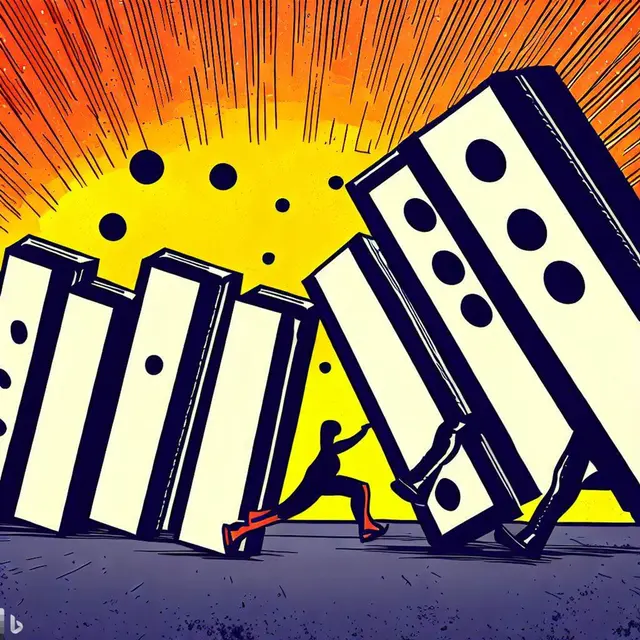
Jun 06, 2023 • Economics
Mortgage Mayhem and Global Grief: A Look at the 2008 Financial Crisis
The Subprime Meltdown: A Comedy of Errors, Without the Laughs

Picture the scene: it's 2008, the world is blissfully enjoying the perks of modern finance when suddenly - bang! A cataclysmic financial storm sweeps the globe, a spectacular confluence of greed, hubris, and catastrophic miscalculation. So let's buckle up and revisit the twists, turns, and pratfalls of the 2008 financial crisis.
Origins of the Crisis: The Housing Bubble
Our story begins with the housing bubble. You see, back in the day, owning a home was not just part of the American dream but the global dream. From the deserts of Arizona to the shores of Spain, owning property was the way to prosperity. So lenders, in their infinite wisdom, decided that practically anyone should qualify for a home loan. Have a pulse? Excellent, here's your mortgage!
Mortgages became as easy to get as candy in a candy store. These risky loans, better known as subprime mortgages, made up 20% of all mortgages in 2006. Here's where it gets really zesty - these mortgages were then bundled into neat little packages known as mortgage-backed securities (MBS) and collateralized debt obligations (CDO), and sold off to investors worldwide.
The Dominoes Begin to Fall: Financial Institutions on Thin Ice
Investors loved these mortgage bundles. They were buying them faster than hotcakes at a Sunday breakfast. But alas, the sugar high was not to last. By 2007, those pesky subprime mortgage borrowers started defaulting on their loans at an alarming rate. The response? A collective gasp as everyone realized these financial 'assets' were as valuable as a stack of old newspapers.
Bear Stearns, once the fifth-largest investment bank in the U.S, collapsed under the weight of its exposure to these toxic assets. It was sold to JPMorgan Chase for a measly $2 per share, a far cry from its pre-crisis peak of $133.20 per share.
Global Impact: The Credit Crunch
The contagion spread faster than a cold in a kindergarten. Banks were terrified to lend to each other, let alone anyone else. The term 'credit crunch' became as ubiquitous as 'venti soy latte'. By the fourth quarter of 2008, global GDP growth had plummeted to -2.1%, according to the IMF. That's a whole lot of economic shrinkage!
The Man on the Street: Feeling the Crunch
The global financial crisis was not just an abstract concept affecting invisible investors and far-off financial institutions. It had a real and palpable impact on ordinary people – that’s right, you, me, your neighbor Bob, and Auntie Sally too.
Consider this: between 2007 and 2010, approximately 8.8 million jobs were lost in the US alone. That’s roughly equivalent to every resident in the state of Virginia suddenly being out of work. During this period, the median household income declined by 6.7%, according to the US Census Bureau. Meaning not only were people losing jobs, those with jobs were earning less.
Houses, once the symbol of prosperity, became millstones around homeowners’ necks. Millions found themselves underwater, a term that has nothing to do with swimming and everything to do with owing more on your mortgage than your home is worth. By 2009, one in every 45 homes in the US received a foreclosure notice, according to RealtyTrac.
The Recession: Comparing Apples to Very, Very Sour Apples
The recession that ensued from the global financial crisis was commonly referred to as the Great Recession, presumably because 'The Absolutely Horrendous Downturn' didn’t roll off the tongue quite as easily.
So, how does the Great Recession stack up to other historical recessions? Let’s take a nostalgic stroll down memory lane.
In terms of U.S recessions, the Great Recession was the worst since the Great Depression. Unemployment rates reached levels not seen since the early 1980s recession. However, the peak unemployment rate of 10% in 2009 was still shy of the 24.9% seen during the Great Depression.
Global GDP declined by 0.1% in 2009, according to the World Bank. That might not sound like much, but in the realm of global economics, it's akin to suddenly finding your car doesn't have an engine. By comparison, the 1981-82 recession saw a 1.9% contraction in global GDP.
Recovery from the Great Recession was a slow and arduous process, like trying to run through a pool of molasses. While technically the recession ended in June 2009, the ensuing years were characterized by sluggish growth, high unemployment, and an air of economic malaise that hung around like a bad smell.
Bailouts and Aftermath
Then came the bailouts, the financial equivalent of calling in the cavalry. In the U.S alone, $700 billion was approved via the Troubled Asset Relief Program (TARP) to buy distressed assets and inject capital into banks. Globally, governments unleashed trillions to stabilize their economies.
The crisis left scars that took years to heal. U.S unemployment soared to 10% by October 2009, and globally, the International Labour Organization estimated that the crisis cost 20 million jobs by the end of 2009.
So there you have it, the 2008 financial crisis in a nutshell. It was a rollercoaster ride of booms, busts, and bailouts. The average Joe and Jane were certainly not spared. It serves as a cautionary tale of what can happen when unchecked optimism meets the harsh reality of bad debts. And it forever remains a testament to the global economy's ability to occasionally throw a party that leaves everyone with a ten-year hangover.




